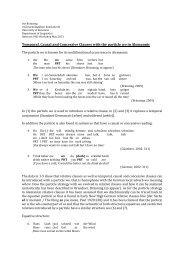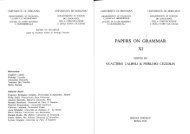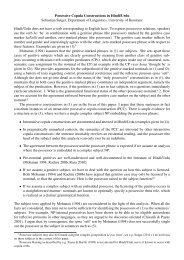Genitive Constructions in Neo-Aramaic I Eleanor Coghill: The ...
Genitive Constructions in Neo-Aramaic I Eleanor Coghill: The ...
Genitive Constructions in Neo-Aramaic I Eleanor Coghill: The ...
You also want an ePaper? Increase the reach of your titles
YUMPU automatically turns print PDFs into web optimized ePapers that Google loves.
<strong>Genitive</strong> <strong>Constructions</strong> <strong>in</strong> <strong>Neo</strong>-<strong>Aramaic</strong><br />
I <strong>Eleanor</strong> <strong>Coghill</strong>: <strong>The</strong> diachrony of genitive constructions <strong>in</strong> <strong>Neo</strong>-<strong>Aramaic</strong><br />
In pre-modern <strong>Aramaic</strong>, e.g. Syriac, a variety of constructions were<br />
available to express a genitive relation, <strong>in</strong> all of which the possessed<br />
noun precedes the possessor. One of these <strong>in</strong>volved the ‘construct’, a<br />
special state of the possessed noun, closely bound to the possessor noun.<br />
<strong>The</strong> others were less closely bound constructions <strong>in</strong>volv<strong>in</strong>g a genitive<br />
particle. Tendencies can be discerned <strong>in</strong> the distributions of each<br />
construction, <strong>in</strong>volv<strong>in</strong>g def<strong>in</strong>iteness among other factors. In <strong>Neo</strong>-<strong>Aramaic</strong><br />
the old construct state is much reduced <strong>in</strong> its distribution, and a new<br />
construction is predom<strong>in</strong>ant, <strong>in</strong>volv<strong>in</strong>g an affix which developed out of the<br />
genitive particle. This presentation will give an brief overview of these<br />
developments.<br />
II Ariel Gutman: Construct state and <strong>Genitive</strong> case <strong>in</strong> North-Eastern <strong>Neo</strong>-<br />
<strong>Aramaic</strong><br />
In the talk we shall present the mark<strong>in</strong>g of the attributive relation <strong>in</strong><br />
North-Eastern <strong>Neo</strong>-<strong>Aramaic</strong>. In NENA, as <strong>in</strong> other Semitic languages, this<br />
relation is mostly head-marked (by means of a construct state) and not<br />
dependent-marked (by means of a genitive case).<br />
We shall concentrate on the Jewish <strong>Neo</strong>-<strong>Aramaic</strong> dialect of Zakho (follow<strong>in</strong>g<br />
the description of Cohen 2012), where a new construct state has emerged<br />
by the <strong>in</strong>corporation of the historical l<strong>in</strong>ker pronoun to the head noun<br />
beside the remnants of the historical construct state (as attested <strong>in</strong><br />
earlier strata of <strong>Aramaic</strong> such as Syriac). <strong>The</strong> <strong>in</strong>corporation of the l<strong>in</strong>ker<br />
pronoun is also responsible for the emergence of special genitive forms of<br />
the demonstrative pronouns and def<strong>in</strong>ite articles, as well as a "genitive"<br />
copula.<br />
This situation will be contrasted with that of the Jewish dialect of<br />
Sanandaj (described <strong>in</strong> Khan 2009) where the construct state has been<br />
replaced by an izafe-like construction borrowed from Persian/Kurdish, thus<br />
widen<strong>in</strong>g the scope of the attributive construction to N + Adj<br />
constructions. In this dialect too, however, a genitive pronoun is still<br />
attested, differ<strong>in</strong>g from some other closely related dialects.







